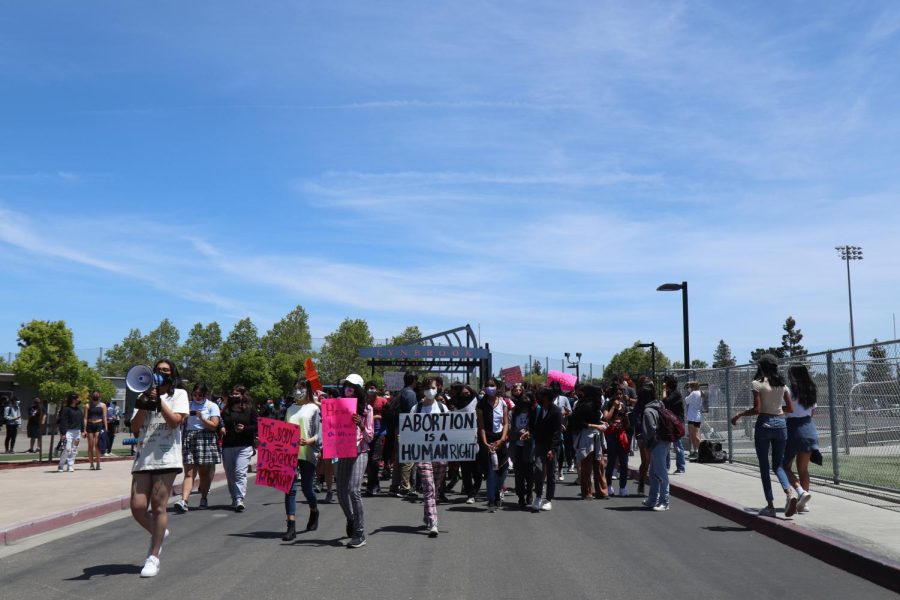What does the death of Roe v. Wade mean?
Abortion has become an increasingly polarizing topic within the nation, making the decision of Roe v. Wade one of the most prominent ones in recent years.
May 26, 2022
“Abortion is a healthcare issue,” gynecologist Priya Panneerselvam said. “Overturning Roe v. Wade does not decrease the number of abortions that will happen in this country — it’s going to decrease the number of safe abortions available to women in this country.”
The leaking of the draft opinion, which will not be final until late June, is the first time in modern history that a draft decision has been disclosed publicly while the case was still pending, making it even more controversial. Roe v. Wade has raised debates nationwide since it was first established in 1973, yet a currently majority conservative Supreme Court has further endangered the ruling of the decision.
“Will the Supreme Court cave in to that public pressure and what might that then suggest about the capabilities of the people to sway such a court?” U.S. History teacher Steven Hsu said. “A leakage is not common evidence, but as a result, it creates precedents to see what future reactions might hold, from the public and from the government.”
The draft opinion pertains to a pending decision for Dobbs v. Jackson Women’s Health Organization, after a doctor from Mississippi’s only licensed abortion facility filed a lawsuit challenging the Gestational Age Act. The act prohibits nearly all abortions after 15 weeks’ gestational age. If the decision does not change, it will overturn Roe v. Wade to allow each state to choose abortion laws without an individual’s protection of privacy by the federal government. Right-leaning states have already begun to declare that they will almost immediately ban abortion if the final opinion reflects the draft. As such, historically pro-choice states like California become “sanctuary states” where women can safely receive legal abortions.
“The decision disproportionately affects people of color in low-income areas in red states,” junior Sanjana Gadaginamath said. “One argument that I’ve heard is, ‘You can just fly to a different state to go get an abortion.’ But that’s just not something everyone can afford to do.”
Laws regarding abortion in the U.S. have always been in flux, with polarizing beliefs rooted in religion, morality, civil liberties, politics and financial motivations. In the 1800s, abortion was largely legal in the country; regulation mostly dealt with the dangerous drugs some women used to induce abortions. But the latter half of the 19th century saw the Catholic Church ban abortion completely. Congress passed the Comstock Law in 1873, which prohibited the distribution of abortion-inducing drugs through the mail.
During the women’s rights movement of the 1960s and 1970s, the Supreme Court initially allowed married couples, then later all unmarried adults, to access birth control and contraceptives. Hawaii became the first state to legalize abortion, followed by New York, Alaska and Washington.
The procedure, however, was not accessible in all states. In 1969, 21-year-old Norma McCorvey, who grew up in poverty and had already put two of her children up for adoption, sought an abortion in Texas. Unable to obtain an illegal procedure, she was referred to two anti-abortion activist attorneys who filed a lawsuit to a Texas district court, which ruled that the state’s abortion ban was illegal because it violated an individual’s constitutional right to privacy.
The case was then brought to the Supreme Court, where four Republican-appointed and three Democratic-appointed justices legalized the procedure nationwide in a 7-2 decision. Justice Harry Blackmun wrote that a woman’s right to abortion was included in the constitutional privacy stated in the 14th Amendment.
“You don’t have to be a constitutional scholar to understand that the idea that the founders did not mean to have privacy in this context is fundamentally erroneous,” AP Government teacher Mike Williams said. “Aside from politics, aside from my view on women’s access to abortion, saying that you don’t have privacy rights in the Constitution requires you to be an extremely strict constructionist.”
McCorvey later became an anti-abortion activist. Shortly before her death, she admitted that her pro-life activism was motivated by financial compensation from anti-abortion organizations.
In addition to protecting one’s liberty to have an abortion without excessive government restriction, the 14th Amendment’s right to privacy and Equal Protection clause also legalizes contraception and same-sex relationships.
“Their decision is saying that your privacy rights are not specifically listed in the Constitution, so they’re not there,” Williams said. “That opens the door for potentially all other rights you have based on privacy, and the Court or states could further use this precedent to limit your particular access to certain things, like gay marriage rights.”
The initial draft leak also included a repudiation of Planned Parenthood v. Casey, a lesser-known but fundamental case in the protection of reproductive rights. When Pennsylvania first amended its Abortion Control Law in 1988, it required informed consent and a 24-hour waiting period in order for the procedure to be done, meaning that the spouse of a married woman or the parent of a minor had to approve of the abortion. The case arose when multiple clinics and physicians, notably the Planned Parenthood of Southeastern Pennsylvania, challenged these requirements.
The main constituent of the argument against the state was the idea of an “undue burden”, which ensures that women should not have any substantial obstacles that prevent them from seeking an abortion before the fetus becomes viable. Viability remains a hotly debated topic, but it usually means anywhere from 22 to 24 weeks into pregnancy or the point at which a fetus can live outside of the mother’s body. However, the definition is highly subjective, as the ability of a fetus to sustain itself also depends on the quality of the neonatal unit or involved doctors. The Supreme Court deemed that the husband notification clause of the legislation fell under the undue burden category, and it was removed.
Abortion laws have remained significant in public discourse throughout history, with the recent Texas Heartbeat Act that has propelled the issue to become a source of alarm for many Americans. In Sept. 2021, the Supreme Court declined to block the Act, which prohibits abortions after detection of a fetal heartbeat with no exceptions for rape or incest. Furthermore, it makes anyone who aids a woman receiving an abortion, such as a doctor, liable to lawsuits from any private citizen. This is the current most restrictive abortion law in the U.S., and critics have commented on contradictions to Roe v. Wade that are present within it, such as the definition of “viability.”
“Abortion is one of many issues that are coming more into prominence as a result of hyperpolarization,” Hsu said. “Ultimately, the current culture war over the procedure has been persistent because there’s no clear way to reason in or out.”





























































